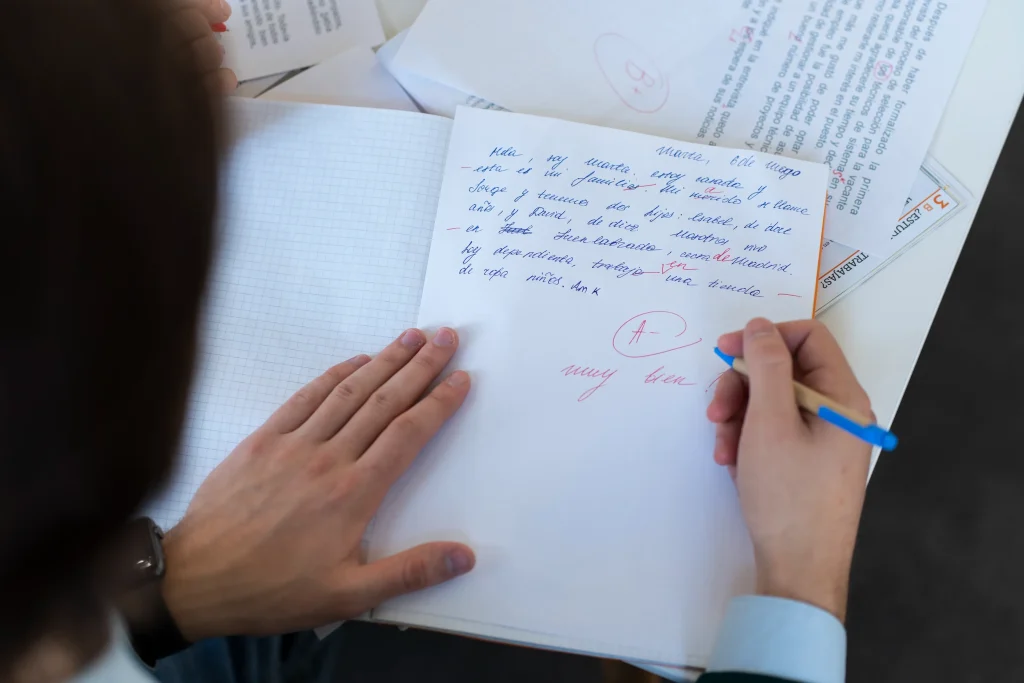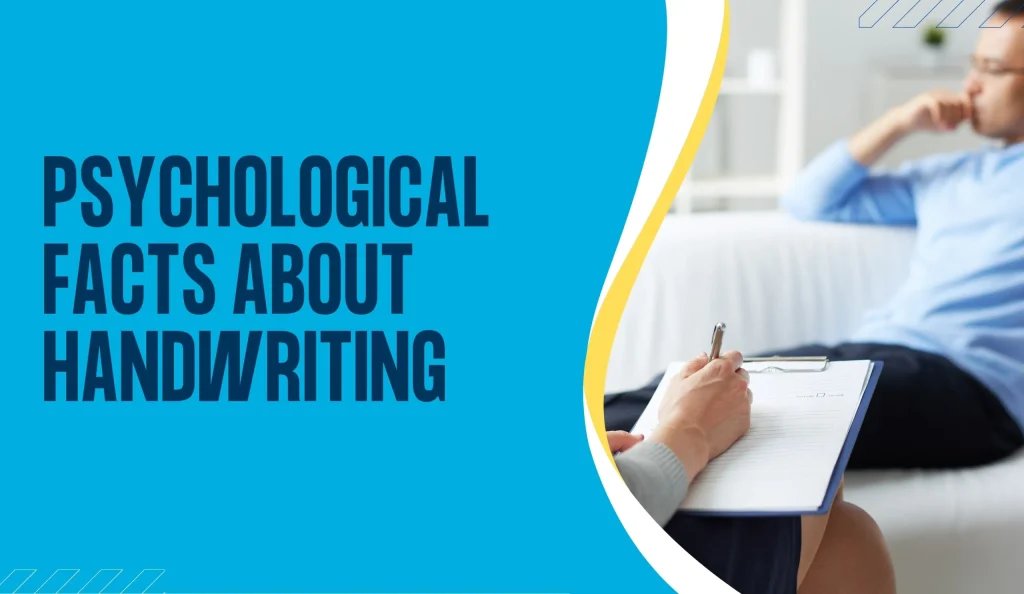Interesting Psychological Facts About Handwriting
Hello Reader!
Welcome to the blog page of the Institute of Graphology, one of the best institute of graphology in Kolkata.
Handwriting is more than just a way of putting words on paper. It is a reflection of our personality, emotions, and even our subconscious mind. For centuries, psychologists and graphologists have studied how handwriting reveals hidden aspects of human behavior. At the Institute of Graphology, led by Dr. Rupa Talukdar, recognized as the best Graphology Institute in Kolkata, we explore the fascinating connection between psychology and handwriting.
In this blog, let us uncover some of the most interesting psychological facts about handwriting that will change the way you look at the written word forever.

1. Handwriting Reflects Your Personality
One of the most well-known psychological facts about handwriting is that every stroke, curve, and slant reflects your personality traits. For example, large handwriting often indicates an outgoing and confident nature, while small and compact writing can show focus, discipline, and introversion. The best Graphology experts study these minute details to understand a person’s character, strengths, and weaknesses.
2. The Pressure of Writing Reveals Emotions
The pressure you apply while writing says a lot about your emotional state. Heavy pressure indicates high emotional energy, determination, or even stress. On the other hand, light handwriting pressure often reflects sensitivity, empathy, or fatigue. At the best Graphology Institute in Kolkata, students are trained to analyze these subtle signs to uncover deeper truths about a person’s psychology.
3. Handwriting and Mental Health
Few people know that handwriting can also indicate a person’s mental health. Changes in writing style, such as irregular spacing, shaky letters, or sudden slants, can point toward anxiety, depression, or nervousness. One of the most crucial psychological facts about handwriting is that it can act as an early warning system for emotional well-being.
4. Spacing Reveals Social Behavior
The space between words and lines in handwriting often reveals how people interact with others. Wide spacing between words usually reflects independence and a desire for personal space, while closely packed writing indicates sociability and a strong need for connection. The Institute of Graphology, considered the best Graphology Institute in Kolkata, helps people understand these behaviors for personal and professional growth.

5. Handwriting Slant Shows Emotional Expression
Another fascinating psychological fact about handwriting is the direction of slant:
- Right slant: Shows openness, warmth, and expressiveness.
- Left slant: Indicates caution, introversion, or a preference for solitude.
- No slant (vertical): Reflects a logical, balanced, and practical personality.
This small detail provides valuable insights into how a person communicates emotions.
6. Signatures Reveal the Real You
While general handwriting reflects how you appear in public, your signature is believed to reveal your true self. A bold, clear signature suggests confidence, while an illegible one may point to privacy or hidden thoughts. As part of training at the best Graphology Institute in Kolkata, signature analysis is taught as a key part of psychological evaluation.
7. Handwriting Changes with Mood
One of the most dynamic psychological facts about handwriting is that it changes depending on your mood. For example, when you are happy, your writing may become more free-flowing and rounded, while during stress or sadness, letters may appear shaky or uneven. This makes handwriting a live mirror of emotions.

How can handwriting reveal personality traits?
Handwriting can reveal a variety of personality traits through specific features analyzed in graphology, the science of handwriting interpretation. Here’s how these traits manifest:
Size of Handwriting
- Large handwriting is associated with extroversion, a desire for attention, and sociability, while small handwriting may suggest introversion, focus, and attention to detail.
- Medium-sized writing often indicates a balanced personality.
Slant and Alignment
- Rightward slanting letters are seen in passionate and outgoing personalities; leftward slant is linked to reserved or introspective individuals.
- Handwriting that maintains a straight alignment on the page often reflects focus and responsibility, while curving lines may indicate distraction or emotional unpredictability.
Pressure and Line Thickness
- Heavy pressure tends to signal strong emotions, determination, and assertiveness; light pressure can indicate sensitivity and a delicate nature.
- Thin lines point to gentleness and avoidance of conflict, while thicker lines suggest assertiveness.
Spacing and Loops
- Wide spacing between words or letters signals independence and creativity, whereas close spacing may indicate preference for social connection and a pragmatic approach.
- Loops in letters such as “l” and “e” can also be revealing: a full loop on “l” means spontaneity, no loop hints at feeling restricted; a small “e” loop may mean skepticism, a large loop points to open-mindedness.
Letter Shape and Signature
- Rounded letters often reflect creativity and a nurturing disposition; angular letters indicate analytical thinking and directness.
- Signatures can also provide clues: a large, embellished signature may signify need for recognition and confidence, while a smaller, simpler one could suggest humility or reserved nature.
Beyond the Science
While fun and intriguing, graphology should be seen as one lens among many for understanding personality, given variability and the lack of consistent empirical validation. Nevertheless, these features offer valuable insights into facets of individual character and emotional style. Handwriting can reveal personality traits by analyzing characteristics such as size, slant, spacing, pressure, and letter formation. Graphology suggests that these features reflect aspects of attitude, emotion, and interpersonal behavior in meaningful ways.

Main Features That Indicate Traits
- Large handwriting is often linked with extroversion, confidence, and a desire to be noticed, while small handwriting points to introversion, focus, and carefulness.
- Rightward slanting letters are associated with outgoing personalities and emotional expressiveness, leftward slant indicates introspection and caution, and upright writing suggests logic and neutrality.
- Wide word and letter spacing may indicate a need for independence, while tightly spaced writing signals desire for closeness and sociability.
- Heavy pressure usually reflects emotional intensity and determination; light pressure is seen in sensitive, adaptable individuals.
- Rounded letters suggest creativity and warmth, angular letters show analytical thinking and directness.
- A consistently straight baseline demonstrates stability; waviness or sudden dips can imply mood swings or distraction.
- The style and size of one’s signature can indicate self-esteem, confidence, or humility.
Evidence and Limitations
Although many personality traits have been linked to handwriting by graphologists, psychological science notes that interpretation should be cautious; handwriting reflects complex interactions between motor skills, environment, and emotions, rather than serving as a definitive diagnostic tool.

How do researchers test graphology’s accuracy?
Researchers test the accuracy of graphology using several scientific and empirical methods focused on comparing handwriting analysis results with accepted psychological assessments and observed behaviors:
Correlation with Psychological Tests
- Studies commonly evaluate whether graphological analysis correlates with standardized personality tests such as the Big Five Personality Traits or Myers-Briggs Type Indicator (MBTI). These tests serve as benchmarks to compare handwriting-based personality predictions. For example, researchers assess how well graphologists’ interpretations match scores on these validated instruments.
- Such studies have found mixed and often conflicting results, with some showing weak correlations and others no better than chance accuracy.
Blind and Controlled Evaluations
- Researchers conduct blind assessments in which graphologists analyze handwriting samples without knowledge of the writer’s actual personality traits. Their personality descriptions are then compared against self-reports or observer ratings for accuracy.
- Some studies try to control for common psychological biases like the Barnum effect (where vague, universally applicable statements seem personally accurate), to ensure that results genuinely reflect handwriting features and not generic traits attributed by the analyst.
Consistency and Agreement Studies
- Tests examine whether different graphologists produce consistent personality evaluations from the same handwriting samples. Low inter-rater reliability weakens the validity of graphology as a scientific discipline.
- Similarly, repeated assessments by the same graphologist under different conditions are checked for consistency.
Experimental and Automated Approaches
- Modern research uses computer vision and machine learning algorithms to extract objective handwriting features such as pressure, spacing, and stroke angles, attempting to automate personality trait predictions. These models are trained on labeled handwriting datasets and tested on new samples to evaluate accuracy, typically measured through metrics like accuracy and loss functions.
- Some experimental models have achieved prediction accuracies of around 90%+ on controlled datasets, but these are usually narrow in scope and require further validation in real-world settings.
Criticism and Limitations
- Despite ongoing research, mainstream psychological science views graphology skeptically due to inconsistent empirical evidence, subjective interpretation, and confounding factors such as motor skills, educational background, and emotional states affecting handwriting independently of stable personality traits.
- Overall, the scientific consensus is that graphology lacks strong predictive validity for personality assessment, with recommendations to use it cautiously as a complementary rather than primary tool.
In essence, researchers test graphology’s accuracy mainly through comparison to validated psychological tests, blind rating studies, consistency checks, and automated feature analysis, but results remain inconclusive and caution against overreliance.
Also Read: Does Changing Your Handwriting Change You?

Which statistical metrics assess predictive accuracy?
Statistical metrics commonly used to assess predictive accuracy vary depending on the type of prediction task—classification or regression.
For Classification Tasks
- Accuracy: Percentage of total correct predictions out of all predictions made. Good for balanced datasets but can be misleading if classes are imbalanced.
- Precision: Proportion of positive predictions that are actually correct. Important when false positives carry a high cost.
- Recall (Sensitivity): Proportion of actual positives correctly identified. Important when missing positives has high consequences.
- F1-Score: Harmonic mean of precision and recall, balancing both metrics.
- Specificity: Proportion of actual negatives correctly identified.
- AUC-ROC (Area Under the Curve – Receiver Operating Characteristic): Evaluates model sensitivity and specificity across all classification thresholds.
For Regression Tasks
- Mean Squared Error (MSE): Average of squared differences between predicted and actual values; penalizes large errors heavily.
- Root Mean Squared Error (RMSE): Square root of MSE, expressed in original units to improve interpretability.
- Mean Absolute Error (MAE): Average of absolute differences between predicted and actual values; simpler and less sensitive to outliers than MSE.
- R-squared (Coefficient of Determination): Proportion of variance in the dependent variable explained by the model; ranges from 0 to 1, with higher values indicating better fit.
Usage Context
- Accuracy alone can be misleading for imbalanced data, where precision, recall, and F1-score provide more nuanced views.
- For continuous outcome predictions, MSE, RMSE, MAE, and R-squared are the most informative.
- Evaluation often involves confusion matrices for classification to understand true/false positives/negatives comprehensively.
These metrics collectively ensure rigorous, comprehensive evaluation of a predictive model’s performance.

Which brain processes change when writing by hand?
Writing by hand engages and changes several brain processes compared to typing or other forms of writing. Key brain processes and regions that change when writing by hand include:
- Sensorimotor Cortex Activation: Handwriting requires complex coordination of fine motor skills for forming letters, which activates the sensorimotor cortex associated with tactile feedback and motor control.
- Visual Processing Areas: Writing by hand engages visual brain regions for letter recognition and real-time monitoring of letter shapes, primarily involving the visual word form area (VWFA) in the ventral occipitotemporal cortex.
- Language Centers: Handwriting activates language-related brain areas like Broca’s area and the inferior frontal gyrus, supporting phoneme-to-grapheme conversion and orthographic encoding.
- Parietal Lobes: The superior parietal lobule and anterior intraparietal sulcus participate in visuospatial integration and motor planning specific to handwriting movements.
- Cerebellum and Motor Areas: The cerebellum contributes to movement precision, coordination, and timing adjustments crucial for fluid handwriting. Primary motor cortex and supplementary motor area coordinate execution of fine motor commands.
- Increased Connectivity: Writing by hand shows more elaborate and widespread connectivity between brain regions, particularly within theta and alpha frequency bands, which are linked to memory encoding, working memory, and sensorimotor integration.
- Memory and Learning Advantages: Handwriting engages neural circuits more deeply involved in memory formation and learning compared to typing, resulting in improved retention and comprehension.

FAQ
Q1. Can handwriting really reveal personality traits?
Yes. Handwriting reflects subconscious patterns, showing traits like confidence, introversion, creativity, or emotional balance.
Q2. How does handwriting relate to emotions?
The pressure, slant, and flow of handwriting often change with emotions, indicating stress, happiness, or anxiety.
Q3. Can handwriting help in detecting mental health issues?
Yes. Irregularities such as shaky letters, uneven spacing, or sudden changes can reflect underlying emotional or psychological issues.
Q4. Does spacing in handwriting have psychological meaning?
Absolutely. Wide spacing often shows independence, while closely packed writing suggests sociability and a need for connection.
Q5. Why is signature analysis important in handwriting psychology?
A signature reflects one’s true self—confidence, privacy, or personality traits—often more deeply than normal handwriting.
Conclusion
Handwriting is not just about communication—it is a window into the human mind. By studying these psychological facts about handwriting, one can understand personality, emotional states, and even hidden potentials. At the Institute of Graphology, under the guidance of Dr. Rupa Talukdar, the best Graphology Institute in Kolkata, we dedicate ourselves to unlocking these mysteries and training individuals in the science of handwriting analysis.
If you are curious to know what your handwriting says about you, or if you want to learn the art of graphology, the Institute of Graphology is your ultimate destination.
